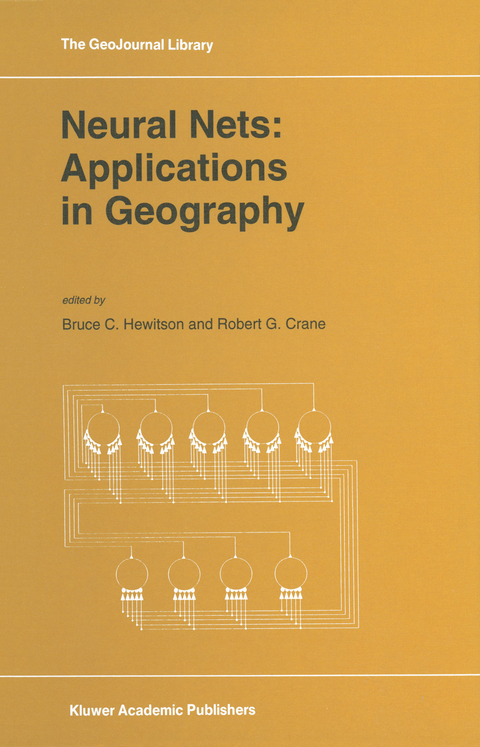
Neural Nets: Applications in Geography
Springer (Verlag)
978-94-010-4490-5 (ISBN)
The volume presents an introduction to neural nets that describes some of the basic concepts, as well as providing a more mathematical treatise for those wishing further details on neural net architecture. The bulk of the text, however, is devoted to descriptions of neural net applications in such broad-ranging fields as census analysis, predicting the spread of AIDS, describing synoptic controls on mountain snowfall, examining the relationships between atmospheric circulation and tropical rainfall, and the remote sensing of polar cloud and sea ice characteristics.
The text illustrates neural nets employed in modes analogous to multiple regression analysis, cluster analysis, and maximum likelihood classification. Not only are the neural nets shown to be equal or superior to these more conventional methods, particularly where the relationships have a strong nonlinear component, but they are also shown to contain significant explanatory power. Several chapters demonstrate that the nets themselves can be decomposed to illuminate causative linkages between different events in both the physical and human environments.
One — Looks and Uses.- 1.0 Origins and Growth.- 1.1 Conceptual Overview.- 1.2 Neural Net Structures.- 1.3 Implementing the Neural Net.- 1.4 Inevitable Caveats and Cautions.- 1.5 Where Next?.- Two — Neural Networks and their Applications.- 2.0 Introduction.- 2.1 Neural Network Language and Basic Operation.- 2.2 Multilayer Perceptrons and the Backpropagation of Error Algorithm.- 2.3 Kohonen’s Self-Organizing Feature Maps.- 2.4 Neural Networks and System Identification.- 2.5 Areas of Current Research.- Three — Neuro Classification of Spatial Data.- 3.0 Towards a Computational Geography.- 3.1 Whither Neuroclassification?.- 3.2 Review of Potential Neuroclassifier Architectures.- 3.3 Competitive Learning Nets.- 3.4 Self-Organizing Map.- 3.5 Adaptive Resonance Theory.- 3.6 Associative Memory Nets.- 3.7 Comparisons With Conventional Classifiers.- 3.8 Kohonen’s Self-Organizing Map.- 3.9 Conclusions.- ChapterChapter Four — Self Organizing Maps — Application to Census Data.- 4.0 South African Census Records.- 4.1 Net Classification.- 4.2 Interpretation of the Mapping Surface.- 4.3 Interpretation of Regions in the Mapping —The ‘Black’ Population.- 4.4 Spatial Distribution of the Mapping.- 4.5 Conclusions.- Five - Predicting Snowfall from Synoptic Circulation: A Comparison of Linear Regression and Neural Network Methodologies.- 5.0 Introduction.- 5.1 Data Preparation and Methodology.- 5.2 Principal Component Analysis — 700 mb Data.- 5.3 SNOTEL Data Preparation.- 5.4 Stepwise Multiple Regression Analyses.- 5.5 Five-Day Smoothed Results.- 5.6 Neural Network Analysis.- 5.7 Conclusions.- Six - Neural Computing and the Aids Pandemic: The Case of Ohio.- 6.0 The AIDS Pandemic, circa, 1993.- 6.1 Spatiotemporal Neural Forecasting.- 6.2 Neural Forecasting of the AIDSEpidemic.- 6.3 A Sensitivity Analysis.- 6.4 Neural Spatiotemporal Forecasting: Qualified Conclusions.- Seven - Precipitation Controls in Southern Mexico.- 7.0 The Issue.- 7.1 Southern Mexico Precipitation.- 7.2 Climate Representation in the Data Set.- 7.3 Neural Net Design and Training.- 7.4 Neural Net Interpretation-Theory.- 7.5 Neural Net Interpretation — Implementation.- 7.6 Precipitation Onset.- 7.7 Early Established Summer Rains.- 7.8 Late Summer Precipitation Maximum.- 7.9 Decay of the Summer Rains.- 7.10 Conclusions.- Eight - Classification of Arctic Cloud and Sea Ice Features in Multi-Spectral Satellite Data.- 8.0 Introduction.- 8.1 Cloud Detection and Classification.- 8.2 Cloud Pattern Analysis Using Texture.- 8.3 Discussion.- 8.4 Other Neural Network Applications to Cloud Classification.- 8.5 Sea Ice Fracture Patterns.- 8.6 Neural Network Approach.- 8.7 Conclusions.- Appendix I - Neural Network Resources.- Appendix II - Fortran 77 Listing for Kohonen Self Organizing Map.
| Reihe/Serie | GeoJournal Library ; 29 |
|---|---|
| Zusatzinfo | XI, 196 p. |
| Verlagsort | Dordrecht |
| Sprache | englisch |
| Maße | 160 x 240 mm |
| Themenwelt | Mathematik / Informatik ► Informatik ► Theorie / Studium |
| Naturwissenschaften ► Geowissenschaften ► Geografie / Kartografie | |
| Naturwissenschaften ► Physik / Astronomie ► Thermodynamik | |
| Sozialwissenschaften ► Soziologie ► Empirische Sozialforschung | |
| ISBN-10 | 94-010-4490-2 / 9401044902 |
| ISBN-13 | 978-94-010-4490-5 / 9789401044905 |
| Zustand | Neuware |
| Haben Sie eine Frage zum Produkt? |
aus dem Bereich


